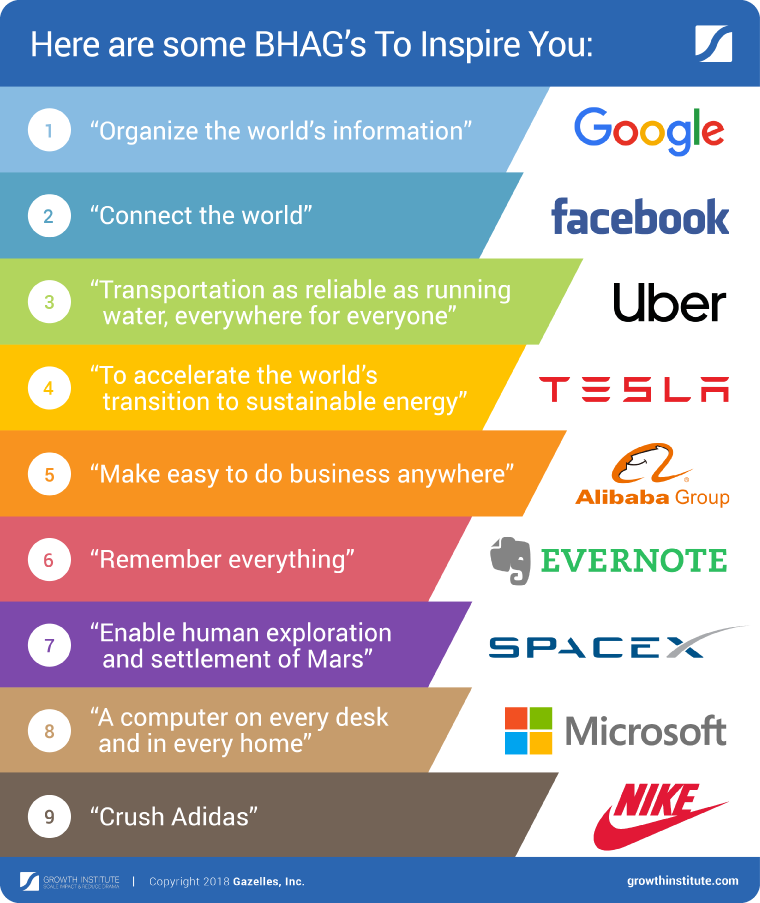Businesses goals are subitems within the overall strategy and vision of the business. Business goals are generally articulated in the context of business mission and may be called out as specific intentions of the business in terms of markets, products and people.
Jim Collins and Jerry Porras in their book, Built to Last: Successful Habits of Visionary Companies called out the notion of a Big, Hairy, Audacious Goal or BHAG – a long-term, ten to twenty five year goal, guided by the company’s core values and purpose.
These days the BHAG could be much more contracted in its horizon and in fact probably be something more in line with a one to three year horizon. A lot depends on the industry segment and the age of the company.
A business, as mentioned, may have a number of people, product and market goals but there will typically be one particular goal that stands out as audatious or particularly ambitious.
Ultimately the BHAG is nevertheless part of a the bigger picture framed by the corporate vision and mission of the company.
The goals (and BHAG) , objectives, and action plans simply drive toward achieving the company mission.
Frequently referred to, BHAGs you could consider as reference point, would be
- Henry Ford : “a motor car for the great multitude”.
- Robert Kennedy Junior : “We choose to go to the Moon”
- Jack Welsh : “Become #1 or #2 in every market we serve…”
Here is another list though, perhaps a little more contemporary from the growthinstitute and Gazelles Inc .

Collins and Porras consider a number of different kinds of BHAGs, which are viewed as strong imperatives for a business to push forward wit hthe mission. for teams to align and push hard.
Target-Oriented
Many companies will set bold statistically measurable qualitative targets such as x amount of revenue otr n number of units. As with anything of course these need to be measured in the sense that they should be Meaningful, Achievable and Realistic in the context of S.M.A.R.T. By that I mean meaningful to to the team.
For product managers this is tricky because often the product manager has no control over the sales or selling organization unless the go to market is all online sales, in which case, the next question is how much influence and control do the product team have over the market budget and funnel build.
There is a certain specificity to these target oriented goals. For example, one company that I worked for had the goal of $100M in annual turnover within 5 years. Another would be something like the WalMart 1990 goal of $125 billion company by year 2000. Your product BHAG may be more modest, perhaps a specified number of features, a performance benchmark or a particular number of customers on your product advisory board. The latter may not be a product goal but is certainly is a product management goal.
Competitive
Collins and Porras reference this as the attack on the “Common-Enemy”, it is something that will particularly resonate for teams that are made of people that come from competitor organizations or who view a particular competitor as something that “must be beat” or displaced, this is especially true if the competitor is the current dominant player in a particular market. Again commonly cited examples here might be that Nike #9 quote above. Equally, you might consider Tesla’s more subtle plans to displace the big established automotive manufacturers. When I worked in the telecommunications business, our goalwas to displace AT&T, Sprint and Verizon. We would do that by making sure that we had coverage in the metropolitan centres, had the latest flashiest handsets and innovation at the front lines with service and product. We would never be as big as them but we could get to position No.3 and give the two bigger players a hard run.
Transformative
A third kind of BHAG is one that drives Internal transformation of your business. Best suited for large and established companies (the likes of Alphabet, Microsoft, Apple, Philips, Siemens and GE).
In such companies the key is to changing the inter-business-unit functions such that the business becomes more agile and lean in the execution of the business mission.
No mean feat since there is likely a great deal of diversity in the business and lot of inter-BU competitiveness. Here you can look at transfer costs associated with dog-fooding your product internally. Demonstrating the lowest cost of production for every unit sold or the highest level of customer satisfaction for your lines inter-bu. The point here is that you’re really competing across the internals of the business.
Role Model
Is there a competitor in your space that your business admires? Unlike the competitive BHAG, here you’re tipping your hat at a particular competitor and saying, “you know what? we wnat to be more like them!“
To do this you have to work out what it is about that competitor that you admire so much and then consider what it would take to be more like them.
As a product manager it might be the simplicity, ease of use, reliability or feature-richness of the competitor product. Either way, work out what it is and then lay that down as the goal to pursue.
I’ll conclude with the sage advice of Francis Dion
A well-formulated BHAG must have clear success criteria with a “line-in-the-sand” timeline. It has to be compelling for all, difficult but believable, scary but in a good way…
